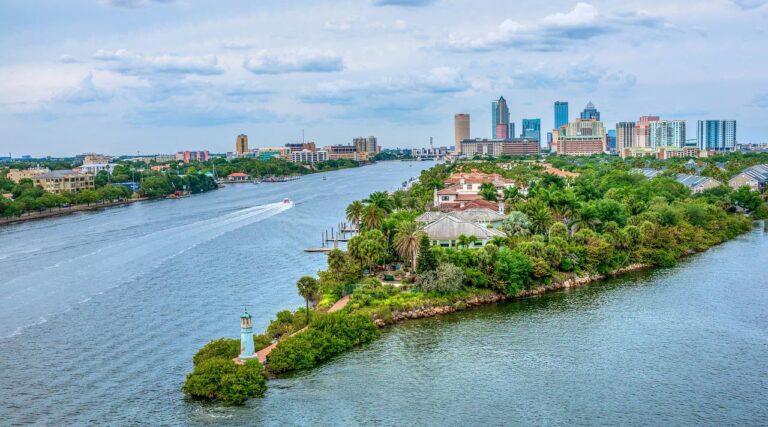
Many real estate investors believe Tampa short-term rentals are a great investment. Should you be considering them, too?
In the past 2 years, the Tampa Bay housing market has been the least vulnerable to the effects of the Coronavirus pandemic.
In fact, Tampa Bay metro will be the No. 1 hottest housing market for this year. That’s based on January 2022 predictions by Zillow, the online real estate marketplace giant. It said the city tops the list due to a combination of strong home value growth, a thriving job market, a scarce and fast-moving inventory, and demographics that indicate a good number of potential buyers.
Zillow expects Tampa to rise from the fourth-fastest in home value growth in 2021 to fastest in 2022. The typical home value in the metro right now is $347,697, going up 31.5% over the past year.
Though home prices are rising because of low mortgage rates and tight supply, they’re still low compared to many markets across the United States. Tampa properties actually have a good chance for a strong appreciation in the coming years.
Tampa right now is a seller’s market – which means there are more people looking to buy than there are homes available. The sale-to-list price ratio is 100%, which means houses are sold for approximately the asking price on average.
Realtor.com says home sales in the city are expected to surge by 9.6% while prices are projected to rise by 6.8% year-over-year.
What’s happening now, as reported by the Tampa Bay Times, is that Tampa is experiencing a “meteoric rise” in desirability – especially for people flocking from around the country. Despite skyrocketing real estate prices, Tampa Bay is still relatively cheap for folks coming in from high-cost cities in New York and California.
Let’s take a look at the different forces driving this bull market.
Located in western Florida along Tampa Bay and the Gulf of Mexico, the Tampa Bay metro area, which includes the cities of St. Petersburg, Clearwater and Tampa is the 18th largest metropolitan area in the U.S.
These 3 distinct cities are scattered across 2 counties, Hillsborough and Pinellas. The Tampa Bay Metro area, with a population of over 3.1 million, is the 3rd most populous metro in Florida after Miami and Jacksonville.
The city of Tampa alone, which consists of 94 neighborhoods, has close to 388,000 residents.
Population growth was pegged at 1.17% last year and is projected to rise annually at 3.3% over the next few years. By 2024, the metro area’s population is projected to increase by 126,300 residents.
Tampa’s economy has a diverse base of finance, technology, tourism, healthcare, manufacturing, defense, and construction industries.
The GDP of Tampa is more than $169 billion, growing by 14% over the last decade.
As of September 2021, the Tampa area gained the most private-sector jobs of all metro areas in Florida. Some 84,600 jobs were added that year, amounting to a 7.2% increase. The city’s unemployment rate dropped to 3.9% in September, down from 6% reported a year before.
Along with the above industries, high-paying professional business services are also driving a steady increase in job growth. The metro is home to 20 corporate headquarters with over $1 billion in annual revenue, 8 of which are Fortune 1000 companies. Almost 500 foreign-owned companies from more than 40 different nations are established in the area.
The Port of Tampa, the largest in Florida, is also keeping the logistics and distribution industries robust.
Furthermore, Bill Gates has partnered with businessman Jeff Vinik (owner of the Tampa Bay Lightning hockey team) to develop Water Street Tampa, a $3 billion development project that is transforming the downtown waterfront into a 9 million-square-foot complex. It’ll consist of a mix of modern commercial, residential, educational, and entertainment spaces.
Tampa’s mild winters and subtropical weather throughout the year make it a magnet for Americans trying to escape the cold northern states. The average temperature is 99F, which is comparably warm and comfortable.
Retirees, millennials and young families flock to this snowbird city because of its pristine beaches, unspoiled nature and a plethora of leisure, entertainment, art, sports and dining attractions. (And we all know an influx in tourism means greater demand for Tampa short-term furnished rentals.)
The popular tourist attractions in Tampa are the Florida Aquarium, the Tampa Museum of Art, Busch Gardens Florida, and Tampa Bay History Center, Zoo Tampa at Lowry Park, Big Cat Rescue, and Adventure Island, among others.
It’s important to note that Tampa International Airport, St. Petersburg-Clearwater International and Sarasota-Bradenton International are all located within the metro area and provide non-stop service to more than 90 domestic and foreign destinations.

Livability.com says Tampa has completely transformed itself into a completely desirable and competitive city. Ever since the Great Recession of 2008, the metro area has managed to get back up and reinvent itself. From the development of its downtown and waterfront areas to its warm weather, year-round festivities, and affordability, there are plenty of reasons why “everyone is moving to Tampa right now”.
US News and World Report ranked Tampa #6 in Best Places to Retire, #6 in Best Places to Live in Florida, and #9 in Safest Places to Live among 150 metro areas in the country.
Additionally, the cost of living in the city is 5% lower than the national average. Niche.com gave it top marks in diversity, nightlife, and livability for families. Tampa’s numerous bars, restaurants, coffee shops and parks are a huge draw, as is the city’s above-average public schools.
Most of Tampa residents are inward migrants from other areas of the U.S., drawn to the area’s fabulous weather, better quality of life, job opportunities and leisure activities.
The state of Florida is one of only 7 states that don’t collect individual taxes. While you would still have to pay the state and local taxes, no personal income tax will be required of you.
Check out this Florida Tax Guide to get a quick look at various taxes levied by the state.
Short-term renting is absolutely legal – both in Tampa and the rest of Florida. In fact, when it comes to short-term rental laws, the state of Florida is one of the most Airbnb-friendly in the US. It has banned local governments from passing laws that prohibit short-term renting.
However, there are various state, county and city regulations that you have to follow. Check with both the Florida and Tampa official websites to be aware of any changes in short-term rental regulations.
If you don’t already know, Florida is an Airbnb hotspot. Before the Covid-19 pandemic, over 6.6 million people visited the state through the company’s online travel booking platform. Airbnb’s Floridian hosts collectively received $1.2 billion in supplemental income in 2019.
Pinellas County received 331,000 visitors, generating $67.2 million. Hillsborough Country saw 247,000 visitors and made $33.7 million.
And despite the pandemic, Florida and Tampa have continued to welcome visitors. And they’ll likely continue seeing business and leisure travelers in the next few years.
The booming tourism has made Tampa a hotspot for real estate investors, too. Hillsborough and Pinellas offer a variety of opportunities for residential and commercial rentals, both in suburban and high-density downtown areas.
In fact, Tampa is one of the best cities for rental arbitrage in the country, according to short-term rental data analytics site AirDNA. The company tracks the daily performance of over 10 million properties in 120,000 global markets. For 2021, it reported the following figures:

Because real estate in Tampa is expected to appreciate in 2022 and in the coming years, now is a great time to invest in properties. Hold on to them for some time so that when the selling price gets much higher in the future, you can sell them off and get a good return. Get properties at lower rates now, then rent them out to short-term guests to improve your cash flow.
And when it comes to property management, we can help you with the in’s and out’s – not just in Tampa, but also in some of the hottest real estate markets in the United States.
Cohostit provides turnkey management services – from marketing to optimization to issue resolution – and everything in between. They’ll help you minimize the risks and optimize your efficiency and, ultimately, your revenues. Click here to see if you qualify.